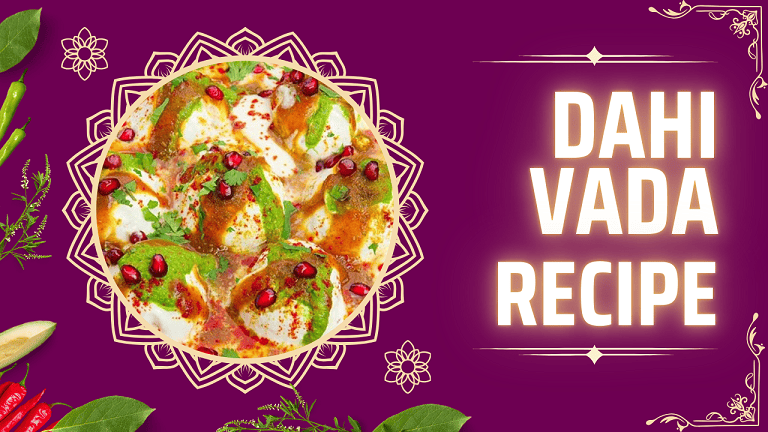Dahi Vada Recipe
Dahi Vada, also known as Dahi Bhalla in some regions of India, is a traditional North Indian snack that beautifully marries the crispy texture of fried lentil dumplings with the cooling creaminess of yogurt.
Served as a refreshing dish, it is particularly popular during the summer months and is often enjoyed as a part of festive celebrations, family gatherings, and street food culture.
The dish not only tantalizes the taste buds but also offers numerous health benefits, making it a staple in many Indian households.
Health Benefits of Dahi Vada
Protein-Rich: The primary ingredient, urad dal (black gram lentils), is an excellent source of plant-based protein, making Dahi Vada a nutritious option, especially for vegetarians.
Probiotics: The yogurt in Dahi Vada is rich in probiotics, which support gut health and boost immunity.
Cooling Effect: This dish is often served chilled, providing relief from the heat and aiding digestion.
Rich in Nutrients: Depending on the toppings used, Dahi Vada can be enhanced with various spices, herbs, and vegetables, increasing its nutritional profile.
Customizable: You can modify the recipe to cater to dietary needs or preferences, making it suitable for everyone.
Ingredients for Dahi Vada
For the Vadas:
- Urad dal (black gram lentils) – 1 cup (200g)
- Water – For soaking and blending
- Salt – ½ teaspoon (or to taste)
- Green chilies – 2, finely chopped (adjust to taste)
- Ginger – 1-inch piece, grated
- Cumin seeds – 1 teaspoon
- Oil – For frying (preferably mustard or vegetable oil)
For the Yogurt Mixture:
- Thick yogurt (dahi) – 2 cups (500g)
- Salt – ½ teaspoon (or to taste)
- Roasted cumin powder – 1 teaspoon
- Chili powder – ½ teaspoon (or to taste)
- Sugar – 1 teaspoon (optional, to balance the flavors)
- Fresh coriander leaves – 2 tablespoons, finely chopped
For Garnishing:
- Tamarind chutney – ¼ cup (store-bought or homemade)
- Green chutney – ¼ cup (store-bought or homemade)
- Sev (crispy chickpea noodles) – for topping
- Chopped pomegranate seeds – for a burst of color and sweetness (optional)
Step-by-Step Instructions
Prepare the Vadas:
Soak the Dal: Rinse the urad dal under cold water until the water runs clear. Soak it in enough water to cover for 4-6 hours or overnight. This softens the dal and prepares it for grinding.
Drain and Blend: After soaking, drain the dal and transfer it to a blender. Add a little water (about ¼ cup) and blend to a smooth batter. The batter should be fluffy and light, which helps in making the vadas soft.
Add Flavors: Transfer the blended dal to a mixing bowl. Add salt, chopped green chilies, grated ginger, and cumin seeds. Mix well until all the ingredients are evenly incorporated.
Fry the Vadas:
Heat the Oil: In a deep frying pan or kadai, heat oil on medium heat. To check if the oil is ready, drop a small amount of batter into the oil. If it sizzles and comes up quickly, the oil is hot enough.
Shape the Vadas: Wet your hands slightly to prevent sticking. Take a small portion of the batter (about a golf ball-sized) and flatten it slightly to form a disc. Repeat with the remaining batter.
Fry the Vadas: Carefully slide the shaped vadas into the hot oil, ensuring not to overcrowd the pan. Fry them until they are golden brown and crispy on both sides, about 3-4 minutes per side.
Drain Excess Oil: Use a slotted spoon to remove the vadas from the oil and place them on a plate lined with paper towels to absorb excess oil.
Prepare the Yogurt Mixture:
Whisk the Yogurt: In a mixing bowl, whisk the thick yogurt until smooth. Add salt, roasted cumin powder, chili powder, and sugar (if using). Mix well to combine.
Soak the Vadas:
Soak in Water: Take the fried vadas and soak them in warm water for about 10-15 minutes. This softens them, making them absorb the yogurt mixture better.
Drain the Vadas: After soaking, gently squeeze the vadas to remove excess water and arrange them on a serving platter.
Assemble the Dahi Vada:
Layer the Yogurt: Pour the prepared yogurt mixture generously over the soaked vadas, ensuring they are well coated.
Add Chutneys: Drizzle tamarind chutney and green chutney over the yogurt-covered vadas for added flavor.
Garnish: Sprinkle roasted cumin powder, chili powder, and fresh coriander leaves on top. Add a handful of sev for crunch and pomegranate seeds for a pop of color.
Tips for Maximizing Flavor and Nutrition
Use Fresh Ingredients: Opt for fresh urad dal and quality yogurt to ensure the best taste. Local markets often provide fresh produce that can enhance the dish’s flavor.
Proper Soaking: Ensure the urad dal is soaked long enough to achieve a soft consistency. This is crucial for making light and fluffy vadas.
Spice Adjustments: Adjust the level of spices based on your preference. You can also experiment with additional spices like black pepper or chat masala for different flavor profiles.
Herbs and Greens: Incorporating fresh herbs like mint or basil can add a fresh twist to the traditional flavors. They also contribute additional nutrients.
Cooking Oil: Choose healthy oils for frying, such as mustard oil or even avocado oil, for a healthier option. You can also consider shallow frying instead of deep frying to reduce oil usage.
Variations and Substitutions
Vegan Option: Substitute yogurt with a dairy-free yogurt made from almond, coconut, or soy. Ensure it is thick enough to achieve a similar texture.
Gluten-Free: Dahi Vada is naturally gluten-free, but check the chutneys and any packaged ingredients for gluten content.
Different Pulses: Instead of urad dal, you can experiment with other lentils like moong dal (split yellow gram) for a lighter version.
Add Vegetables: Incorporate finely grated vegetables such as carrots or zucchini into the vada mixture for added nutrition and flavor.
Chutney Variations: Try different chutneys like mango chutney or spicy garlic chutney to give the dish a unique twist.
Serving Suggestions
Serve Chilled: Dahi Vada is best served chilled. You can refrigerate the assembled dish for about 30 minutes before serving for a refreshing experience.
Accompaniment: Pair Dahi Vada with a side of crispy papad or bhujia for a crunchy contrast.
On a Festive Platter: Serve Dahi Vada as part of a larger platter featuring other Indian snacks like samosas, pakoras, and kachoris. This variety will make it an appealing centerpiece for any gathering.
Individual Portions: For formal gatherings, consider serving Dahi Vada in small individual bowls or cups for a refined presentation. This also makes it easy for guests to enjoy without the need for serving utensils.
With a Twist: For a modern twist, serve Dahi Vada in a tall glass, layering the vadas and yogurt like a parfait. Top with chutneys, sev, and herbs for an artistic presentation.
Presentation Tips
Use Colorful Bowls: Choose vibrant serving dishes or plates to enhance the visual appeal of the dish. Bright colors can make the dish more inviting.
Layer Creatively: Consider layering the vadas and yogurt in a clear glass for a visually stunning presentation. The layers of white yogurt, golden vadas, and colorful chutneys create an appealing sight.
Garnish Generously: Use fresh herbs and spices to create a beautiful garnish. A sprinkle of pomegranate seeds adds not only color but also a sweet burst of flavor.
Serve with Utensils: Use traditional Indian utensils like small bowls for serving chutneys, enhancing the cultural experience of enjoying Dahi Vada.
Banana Leaf Presentation: For a traditional touch, serve Dahi Vada on a banana leaf, adding an authentic South Indian feel to the presentation.
Conclusion
Dahi Vada is more than just a delightful snack; it’s a celebration of Indian culinary traditions, blending flavors and textures in every bite. With its cooling yogurt, savory vadas, and vibrant chutneys, it exemplifies the art of Indian vegetarian cuisine, providing a nutritious and satisfying experience.
Using fresh, locally sourced ingredients enhances the dish’s flavor and nutritional content while allowing you to explore the rich culinary heritage of India. Whether enjoyed as a street food favorite, a festive snack, or a refreshing appetizer, Dahi Vada is sure to delight your taste buds and impress your guests.
Final Thoughts on Dahi Vada
As you embark on this culinary journey to create Dahi Vada, remember that cooking is not just about following a recipe but about embracing the flavors and traditions that come with it. This dish is not only a fantastic option for satisfying your cravings but also a means to connect with the rich tapestry of Indian culture.
Incorporating locally sourced ingredients supports sustainable practices while celebrating the flavors unique to your region. By making adjustments based on personal preferences or ingredient availability, you can ensure that Dahi Vada can be enjoyed by everyone, regardless of dietary restrictions.
So, gather your ingredients, prepare your workspace, and enjoy the process of creating this delicious and nutritious dish. With every bite of Dahi Vada, you’re not just tasting a dish; you’re indulging in a culinary tradition that has been passed down through generations.
Embrace the Experience
Invite family or friends to join you in the kitchen, as cooking can be a wonderful communal experience. Share tips, stories, and laughter as you prepare the Dahi Vada together. Once the vadas are ready, savor the anticipation as you assemble the dish, appreciating the vibrant colors and aromas.
Serve it as an appetizer at your next gathering, and watch as your guests savor every bite, complementing the delicious flavors with their own personal stories and experiences. You might even inspire someone to continue the tradition and make it their own.
A Journey Through Taste
With its crispy vadas soaked in creamy yogurt, topped with tangy and sweet chutneys, Dahi Vada is truly a dish that embodies the essence of Indian cuisine—diverse, rich in flavor, and full of warmth. It’s a celebration on a plate, perfect for any occasion, be it a family meal, a festive gathering, or simply a moment of indulgence.
Remember to take a moment to appreciate your creation and the joy it brings. Each dish tells a story, and Dahi Vada is a delightful chapter in the rich narrative of Indian culinary artistry. So, enjoy the journey, embrace the flavors, and celebrate the love of cooking!
Serving Ideas for Every Occasion
Picnic Delight: Dahi Vada is an excellent option for picnics. Pack the vadas separately and the yogurt mixture in another container. Just assemble when you’re ready to eat for a fresh taste.
Potluck Hit: This dish is perfect for potluck parties. Prepare a large batch and serve it in a beautiful serving dish, allowing everyone to help themselves.
Street Food Inspired: Recreate the experience of street food by setting up a Dahi Vada station at your next gathering, allowing guests to customize their toppings and garnishes.
Catering for Kids: Children often enjoy fun presentations. Serve Dahi Vada in mini cups or on skewers for an appealing and mess-free option.
Healthy Snacks for Work: Prepare a batch of Dahi Vada and pack them for lunch at work. Pair them with some whole-grain crackers or a side of salad for a complete meal.
Concluding Thoughts
In the world of vegetarian cuisine, Dahi Vada stands out not only for its flavors but also for the joy it brings to those who prepare and share it. With a few simple ingredients and some love, you can create a dish that is not only delicious but also steeped in tradition and culture.
So, as you embark on making Dahi Vada, remember to enjoy every moment—from the preparation to the first bite. Celebrate the process of cooking, the sharing of food, and the cherished memories that come with it. Happy cooking and enjoy your delicious Dahi Vada!
Thanks for visiting Veg Recipe

